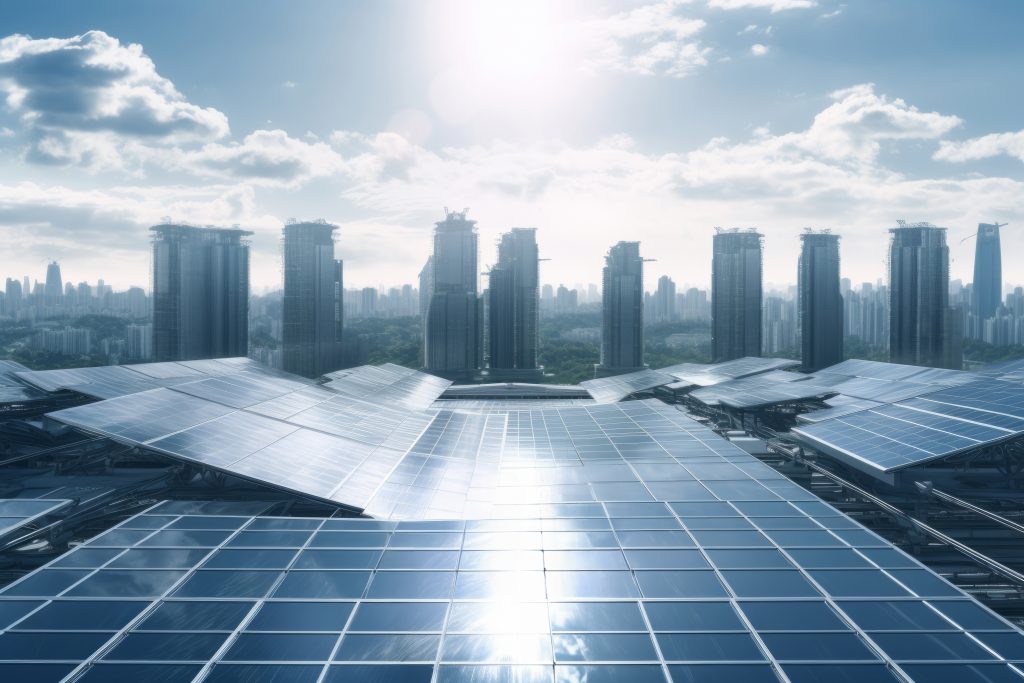India is fast emerging as one of the biggest solar energy markets in the world. The government’s goals for renewable energy and the necessity to decrease the use of fossil fuels have contributed to the development of solar energy in industries and homes. To know how solar energy gets to your rooftop, it is necessary to consider the whole process of solar manufacturing and installation. This journey is called the solar energy supply chain and is crucial for making solar systems affordable, efficient, and available for the Indian market. In this blog, we will discuss the solar energy supply chain and briefly discuss solar manufacturing, logistics in solar energy, sourcing solar components, and installation. The purpose is to give an easy-to-understand and concise explanation of how the solar energy industry works in India.
1. Solar Manufacturing: The Backbone of the Supply Chain
The first step in the solar energy supply chain begins with solar manufacturing. This is where the essential components of a solar system—primarily solar panels, inverters, and batteries—are produced. India is heavily investing in its solar manufacturing capabilities to reduce reliance on imports and to meet domestic demand.
The Manufacturing Process
At the core of a solar system are the solar panels, which convert sunlight into electricity. These panels are made up of photovoltaic (PV) cells, typically made from silicon. Here’s a simplified process of how they are manufactured:
Raw Material Sourcing:
The journey starts with sourcing silicon, the primary material used in most solar panels. In India, a significant portion of this material is still imported, though domestic production is growing.
Cell Production:
The silicon is purified, melted, and formed into wafers, which are then assembled into photovoltaic cells. These cells are the building blocks of solar panels.
Panel Assembly:
The cells are arranged in a grid-like pattern and placed between glass and a protective backing. These layers are fused together in a process called lamination, forming a complete solar panel.
Testing and Quality Control:
The finished panels go through rigorous testing to ensure they meet efficiency and durability standards.
Manufacturing isn’t just limited to panels. Solar inverters, which convert the DC electricity generated by the panels into usable AC electricity, and batteries, which store excess energy, are also crucial parts of the supply chain. Like panels, these components are being increasingly manufactured within India, thanks to government incentives.
2. Logistics: Moving Components from Factories to Installers
Once the components are manufactured, they need to be delivered to various points of installation. This is where logistics in solar energy becomes crucial. The logistics process involves the transportation of solar panels, inverters, batteries, and other equipment from factories to distributors and then to installation sites.
Key Challenges in Solar Logistics in India
India’s diverse geography presents several challenges for logistics:
Transportation Networks:
Solar equipment is bulky and requires transportation from manufacturing centers in industrial states such as Gujarat and Tamil Nadu to villages and rooftops of cities across India. Transportation systems are critical in guaranteeing that goods are delivered on time.
Handling and Storage:
Solar panels and inverters are some of the most delicate and costly parts of the solar system. Transportation also poses a risk of damaging the products, which in turn will cost the suppliers and consumers more money. This means that specialized packaging and handling are required to reduce the losses as much as possible.
Sustainability in Supply Chain Logistics:
One of the major issues of focus today is the sustainability of the solar supply chain. This covers the effects of moving the solar components from the amount of carbon emissions from the trucks and ships to the packaging materials. As a result, many companies are now seeking environmentally friendly logistics solutions such as electric trucks or efficient shipping routes.
3. Sourcing Solar Components: India’s Growing Independence
One of the most important steps in the solar supply chain is sourcing solar components. In the past, India relied heavily on imported components, particularly from countries like China, which is the world’s largest producer of solar panels. However, the Indian government is pushing for greater domestic production through initiatives like the Production-Linked Incentive (PLI) Scheme for solar manufacturing.
Domestic Sourcing and its Benefits
As domestic production of solar panels and inverters increases, it brings several benefits:
Reduced Costs:
By producing components locally, India can reduce import costs and tariffs, making solar systems more affordable for consumers.
Job Creation:
Expanding the domestic solar manufacturing sector creates jobs in factories, engineering, and research, contributing to India’s economic growth.
Energy Security:
By reducing dependence on imports, India can ensure greater energy security and reduce its vulnerability to global supply chain disruptions.
4. Installation: Bringing Solar to Rooftops and Fields
The final step in the solar energy supply chain is the installation process. Whether it’s a rooftop system for a home or a large solar farm, installation is where the product finally reaches the end user. Installation involves not just setting up the solar panels but also integrating them with inverters, wiring, and other electrical components.
Installation Best Practices
There are several best practices that ensure a successful installation:
Site Assessment:
Before installation, the site is assessed for solar potential. This includes measuring sunlight exposure, roof space, and determining the correct system size based on the customer’s energy needs.
Panel Placement:
Panels must be positioned to maximize sunlight exposure, usually facing south in India. The tilt of the panels is also important, as it affects how much sunlight they capture throughout the day.
Wiring and Connections:
Connecting the panels to the inverter and the electrical grid (or battery storage) is a critical step. Proper wiring ensures the system is safe and efficient.
Testing and Maintenance:
After installation, the system is tested to ensure it works properly. Regular maintenance, such as cleaning panels and checking connections, ensures the system continues to perform optimally over its lifespan.
Conclusion: The Full Picture of the Solar Energy Supply Chain
The solar energy supply chain in India is complex, involving multiple stages from manufacturing to installation. Each stage plays a critical role in ensuring that solar systems are cost-effective, reliable and accessible. With India’s growing focus on local manufacturing, improvements in logistics, and the push for sustainable practices, the solar energy industry is poised for significant growth in the coming years.





